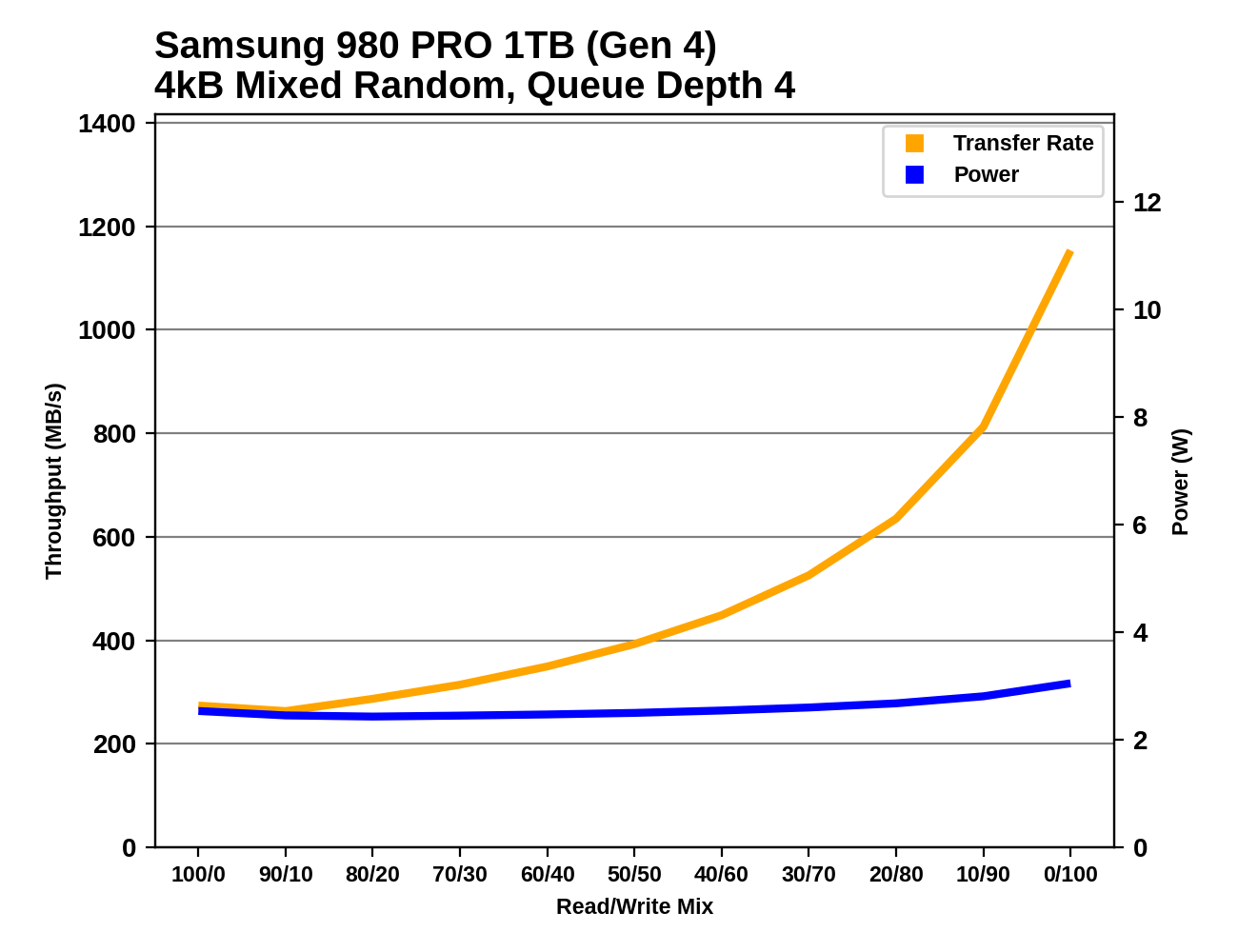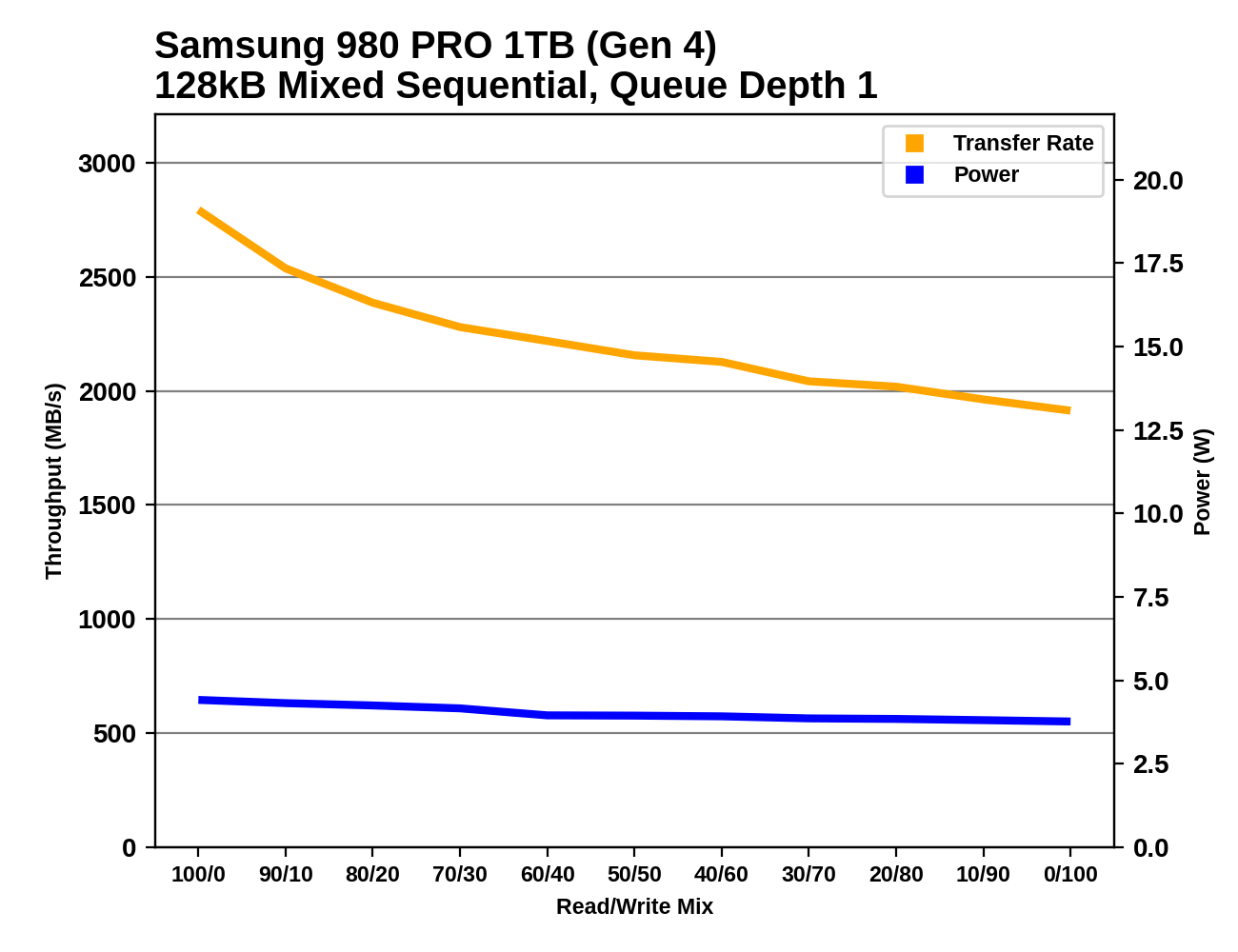The Samsung 980 PRO PCIe 4.0 SSD Review: A Spirit of Hope
by Billy Tallis on September 22, 2020 11:20 AM ESTNote: All our previous testing has been on an Intel test bed. Because of the move to PCIe 4.0, we have upgraded to Ryzen. Devices tested under Ryzen in time for this review are identified in the charts.
Mixed Random Performance
Our test of mixed random reads and writes covers mixes varying from pure reads to pure writes at 10% increments. Each mix is tested for up to 1 minute or 32GB of data transferred. The test is conducted with a queue depth of 4, and is limited to a 64GB span of the drive. In between each mix, the drive is given idle time of up to one minute so that the overall duty cycle is 50%.

Since our mixed random IO test uses a moderate queue depth of 4, the PCIe Gen4 drives don't get much chance to flex their muscle. The overall scores are still generally bound by NAND flash latency, which doesn't vary too widely between current generation drives. There's also a small performance boost when running this test on our newer, faster Ryzen testbed. The Samsung 980 PRO is clearly an improvement over its predecessors, but is merely tied for first place among flash-based drives with the SK hynix Gold P31.
 |
|||||||||
| Power Efficiency in MB/s/W | Average Power in W | ||||||||
Both capacities of the 980 PRO turn in good efficiency scores for the mixed random IO test, substantially improving on Samsung's previously mediocre standing. The 1TB 980 PRO's efficiency is second only to the SK hynix Gold P31. The 980 PROs are a bit more efficient running at PCIe Gen3 speeds than on the Gen4 platform, despite the ~10% performance boost on the faster system.
 |
|||||||||
There are no real surprises in the performance profiles of the 980 PROs. Both capacities show the same general behavior as earlier Samsung drives, albeit with small improvements to performance and power consumption across the board.
Mixed Sequential Performance
Our test of mixed sequential reads and writes differs from the mixed random I/O test by performing 128kB sequential accesses rather than 4kB accesses at random locations, and the sequential test is conducted at queue depth 1. The range of mixes tested is the same, and the timing and limits on data transfers are also the same as above.

The Samsung 980 PROs take the top spots for our mixed sequential IO test, with even the 250GB 980 PRO edging out the 1TB Seagate FireCuda 520. Even when limited to PCIe Gen3, the 980s are a clear step up in performance from eariler high-end drives. The improvement for the 250GB model is the most impressive, since the 250GB 970 EVO Plus is significantly slower than most of the 1TB drives.
 |
|||||||||
| Power Efficiency in MB/s/W | Average Power in W | ||||||||
The 980 PROs turn in more good power efficiency numbers that place them clearly ahead of everything other than the SK hynix Gold P31. And this time, the P31's efficiency lead relatively small at no more than about 25%.
 |
|||||||||
The 980 PROs show a drastically different performance profile compared to earlier Samsung drives. The 970s tend to bottom out during the write-heavy half of the test and recover some performance toward the end. Now with the 980 PRO, performance in the write-heavy half doesn't drop precipitously, so we see a steady decline that most closely resembles how the Intel Optane SSD handles this test










137 Comments
View All Comments
Chaitanya - Tuesday, September 22, 2020 - link
Worse than outgoing 970 series, thanks but no thanks Samsung.Alistair - Tuesday, September 22, 2020 - link
I don't understand the conclusion here. The results were way worse than I expected. It doesn't appear like there is any reason to buy this at all.Exodite - Tuesday, September 22, 2020 - link
So much this.Why wouldn't I get a, different, 2TB drive for the same price as the 1TB 980 Pro when the performance difference is negligible even in synthetic loads?
goatfajitas - Tuesday, September 22, 2020 - link
Its also cheaper, more like a 970 EVO replacement. Thinking of it that way, its a nice bump to replace my EVO. They really shouldn't have called it Pro though.Alistair - Tuesday, September 22, 2020 - link
it isn't even a bump over the PCIe 3.0 Hynix drive...lmcd - Tuesday, September 22, 2020 - link
It's a small bump over the Hynix drive. It's better in latency and burst. Those are both very relevant metrics for day-to-day usage.Spunjji - Wednesday, September 23, 2020 - link
None of these metrics are really relevant in day-to-day usage. In that respect, you won't really notice the difference between any of these and a decent SATA drive.CheapSushi - Thursday, December 17, 2020 - link
It absolutely is. In fact, Optane is even better. The vast majority of people spend their time doing low queue depth random read and write. It IS noticeable unless you ONLY use your PC for Gmail and Facebook.shaddixboggs - Wednesday, September 23, 2020 - link
Lol, why do you think this? You cannot and will not notice that small of a difference.Tomatotech - Tuesday, September 22, 2020 - link
It does seem rather overpriced. Something like the ADATA SX8200 PRO 1TB which is a perfectly fine fast drive hovers around half the price of this. The ADATA drive is slightly worse performing but it’s still a bloody fast NVMe drive and the difference is near undetectable to the user.Other drives are also cheaper and give sustained performance under full disk write (which the ADATA doesn’t, but if you regularly write 900GB in one go to your NVME drive you have special requirements.)